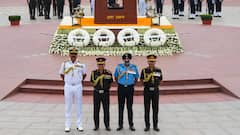'Pralay' To 'BrahMos' — How India Will Showcase Its Military Might At Republic Day Parade 2025
India's military strength will be showcased at the Republic Day parade, featuring a tri-service tableau and advanced weapons systems such as T-90 tanks and Nag, BrahMos, Akash, and Pralay missiles.

Republic Day Parade 2025: India, a non-aligned nation since Independence, has become a global force to reckon with with one of the strongest militaries in the world. At present, India ranks fourth on the Global Firepower Index 2025. The nation's military might is put up on display every year at the Republic Day grand parade along the Kartavya Path (formerly Raj Path). And this year would be no different.
For the first time, the Republic Day parade will feature a tableau integrating aspects of all three wings of the armed forces — the Air Force, the Army, and the Navy. The tableau has been built with the theme ‘Shashakt aur Surakshit Bharat’ (a powerful and safe India).
Indonesia's President, Prabowo Subianto, will be the Chief Guest for the occasion.
Republic Day Parade 2025: Missiles On Display On Kartavya Path
India's Republic Day parade is one of the grandest spectacles in the world. From the President's arrival to the daredevil stunts on bikes and aircraft — the parade has it all.
True to the theme for this year — 'Swarnim Bharat – Virasat aur Vikas' — the Ministry of Defence and various states and ministries will showcase a blend of tradition and technological advancements. President Droupadi Murmu will lead the nation in celebrating the 76th Republic Day on January 26, 2025, at Kartavya Path in New Delhi. This year’s celebrations will highlight the 75th anniversary of the enactment of the Constitution, along with a focus on public participation, or jan bhagidari.
The parade will start with the musical bands and showering of flowers by choppers.
Indonesian Military Contingent At Republic Day Parade
Kartavya Path will also see the participation of the Indonesian National Armed Forces’ marching contingent, consisting of 152 members, along with a 190-member military band from Indonesia’s Military Academy.
The Indian Army's contingent will feature the 61 Cavalry, the world’s only active horsed cavalry regiment, led by Lt Ahaan Kumar. This will be followed by mechanized columns and marching contingents showcasing India’s military strength, including tanks, missile systems, and artillery.
Republic Day Parade 2025: Weapon Systems That Will Be On Display
Prominent military displays will include the T-90 Bhishma tank, NAG Missile System, BrahMos, and the Akash Weapon System, among others.
T-90 Tank
The T-90, specifically the T-90 Bhishma variant, is a main battle tank (MBT) used by the Indian Army since 2003. It is a third-generation MBT based on the Russian T-90S design and has been tailored to meet the specific operational requirements of the Indian military.
The T-90 Bhishma is equipped with a 125 mm smoothbore gun capable of firing various munitions, including armour-piercing fin-stabilized discarding sabot (APFSDS) rounds and guided anti-tank missiles. It can fire up to 800 shells per minute.
Ahilyanagar, Maharashtra: Indian Army conducted a combat exercise at K.K. Range, showcasing advanced tanks like Arjun, Bhishma, and T90. The two-hour drill, organized by the Armored Corps Centre pic.twitter.com/I0kOlX7qtR
— IANS (@ians_india) January 20, 2025
Nag Missile System
The Nag missile system is a third-generation, all-weather, fire-and-forget anti-tank guided missile (ATGM) developed by the Defence Research and Development Organisation (DRDO). It is designed to neutralise heavily fortified enemy tanks.
The Nag missile system has an operational range of 500 metres to 10 kilometres, depending on the variant. The latest version, Nag Mk-2, was tested in Pokhran on January 13. It utilises an imaging infrared (IIR) seeker that locks onto targets before launch, ensuring high accuracy with a hit probability of over 90%.
#WATCH | Field evaluation trials of the DRDO developed Nag Mark 2 anti-tank guided missiles were successfully carried out in the Pokharan firing ranges: DRDO officials pic.twitter.com/0h6G5NyZai
— ANI (@ANI) January 13, 2025
BrahMos Missile
The BrahMos missile is a supersonic cruise missile developed jointly by India's DRDO and Russia's NPO Mashinostroyenia. Capable of being launched from submarines, ships, aircraft, and land platforms, it boasts speeds of up to Mach 3.5 and a range of up to 500 km.
Known for its precision and advanced guidance systems, BrahMos can engage both land and sea targets effectively. Its unique two-stage propulsion system combines a solid propellant booster for initial acceleration with a liquid-fueled ramjet for sustained flight, making it one of the fastest cruise missiles globally. The BrahMos launcher has a 'salvo' mode which can fire 8 missiles in succession with intervals of 2.5 seconds and destroy even a group of targets with anti-missile defence systems.
#StrongAndCapable#YearofTechAbsorption#CINCAN & #GOC #KhargaCorps witnessed perfect #SalvoLaunch of #BrahMos Missiles & validated capability of the formation to engage targets deep into enemy territory with clinical precision #NoTargetTooDeep#ImposersOfNationalWill… pic.twitter.com/MvRzf5uYQK
— Western Command - Indian Army (@westerncomd_IA) January 15, 2025
Pinaka Missile System
Named after the legendary bow of Lord Shiv, the Pinaka missile system is an indigenous multi-barrel rocket launcher (MBRL) developed by the DRDO. Designed for rapid-fire capabilities, it can launch 12 rockets in just 44 seconds, with variants capable of striking targets at ranges from 40 km to 75 km. DRDO plans to enhance the range to beyond 120 km.
The system enhances the artillery firepower of the Indian Army, providing support in offensive operations. First used effectively during the Kargil War in 1999, Pinaka has gained international attention. Armenia received its first batch of Pinaka missiles from India last year in November. Currently, India is using Pinaka Mk-1, with the Mk-2 version of the missile having completed trials.
Akash Weapon System
The Akash missile system is an indigenously developed short-range surface-to-air missile (SAM) designed by the DRDO. It provides area air defence against aerial threats, including fighter jets, drones, and cruise missiles, with an operational range of around 25 and a maximum altitude of 18 km.
The Akash missile system features a multi-function radar, autonomous operation capabilities, and can engage multiple targets simultaneously. Akash is known for its mobility, allowing rapid deployment on mobile platforms, and boosting its effectiveness in various combat scenarios. It is currently used by both the Indian Army and the Air Force.
#WATCH | Indian Army shares a video of the Akash missile system displaying its target engagement capability.
— ABP LIVE (@abplive) March 30, 2024
(Source: ANI)#AkashMissileSystem #IronDome #Defence #IndianArmy #ABPLive pic.twitter.com/EEo2yUGJza
'Pralay' Missile System
The Pralay missile system, an indigenously developed short-range ballistic missile (SRBM), will be the highlight of this year's Republic Day parade. The missile will be on display at the Republic Day Parade for the first time. It has a range of 150-500 kilometres and employs a quasi-ballistic trajectory, allowing it to manoeuvre mid-flight to evade interceptors.
The missile can carry warheads weighing between 350 kg and 700 kg, including high-explosive and penetration-cum-blast types. Pralay is mounted on a mobile launcher for rapid deployment and enhances India's tactical capabilities along its borders with China and Pakistan.
Consecutive second flight test of new surface to surface missile 'Pralay' conducted successfully from Dr APJ Abdul Kalam Island today. #IndigenousTechnologies pic.twitter.com/7TwM8wM1QD
— DRDO (@DRDO_India) December 23, 2021
ALH Dhruv
The Advanced Light Helicopter (Weapon System Integrated), also known as ALH WSI, is an advanced multi-role helicopter developed by Hindustan Aeronautics Limited (HAL) for the Indian Armed Forces. This variant of the ALH, or Dhruv, is equipped with sophisticated avionics, sensors, and weaponry, including a 20 mm turret gun, air-to-air missiles, and the Nag anti-tank missile.
Designed for versatility, it helps in aerial reconnaissance, rescue ops, personnel transport, and close air support. The ALH Dhruv is crucial for operations in challenging terrains.
#IndianNavy's ALH Dhruv Mk-III chopper at #Vizag⚓️ pic.twitter.com/82XYiW47UE
— News IADN (@NewsIADN) July 7, 2024







































